Mapping 30 Years of Sustainability of Solar Energy Research in Developing Countries: Indonesia Case
Abstract
1. Introduction
2. Solar Cell Technologies and Research
2.1. First-Generation Solar Cells
2.2. Second-Generation Solar Cells
2.3. Third-Generation Solar Cells
3. Materials and Methods
4. Results and Discussion
4.1. Research Publication
4.2. Policies Effect on Research Publication
4.3. Geographical Distribution of the Solar Energy Research Publications
4.4. Polarization on Solar Energy Publication
4.5. Evolution of Research Cluster
4.5.1. 2009–2011
4.5.2. 2012–2014
4.5.3. 2015–2017
4.5.4. 2018–2020
4.6. Polarization of Publication in the Affiliation
4.7. Collaboration
4.8. Future Research
5. Conclusions
Author Contributions
Funding
Data Availability Statement
Acknowledgments
Conflicts of Interest
References
- BPPT. Indonesia Energy Outlook: The Impact of Increased Utilization of New and Renewable Energy on the National Economy; Agency for the Assessment and Application of Technology: Jakarta, Indonesia, 2019.
- Law No. 30 of 2007 on Energy. 2007, pp. 2–3. Available online: https://www.dpr.go.id/dokjdih/document/uu/UU_2007_30.pdf (accessed on 24 September 2021).
- Walujanto; Suharyati; Pambudi, S.H.; Wibowo, J.L.; Pratiwi, N.I. Indonesia Energy Outlook. 2018; pp. 35–36. Available online: https://www.esdm.go.id/assets/media/content/content-outlook-energi-indonesia-2018-bahasa-indonesia.pdf (accessed on 24 September 2021).
- Morrison, G.L.; Sudjito. Solar radiation data for indonesia. Sol. Energy 1992, 49, 65–76. [Google Scholar] [CrossRef]
- Solargis. Global Horizontal Irradiance (GHI) and Temperature Profiles at 2m; Global Solar Atlas: Indonesia; Available online: https://globalsolaratlas.info/download/indonesia (accessed on 24 September 2021).
- Sunarso, A.; Ibrahim-Bathis, K.; Murti, S.A.; Budiarto, I.; Ruiz, H.S. GIS-Based Assessment of the Technical and Economic Feasibility of Utility-Scale Solar PV Plants: Case Study in West Kalimantan Province. Sustainability 2020, 12, 6283. [Google Scholar] [CrossRef]
- Presidential Regulation No. 22 of 2017 on National Energy General Plan (RUEN). 2017. Available online: https://www.esdm.go.id/assets/media/content/content-rencana-umum-energi-nasional-ruen.pdf (accessed on 24 September 2021).
- Putri, D.N.N.; Syatriawan, A.; Rizanulhaq, F.; Kartika, T.; Widjaja, M.S.; Kurniawati, N. Techno-Economic of Photovoltaic Rooftop in Indonesia for Commercial and Residential Customer. In Proceedings of the 2020 6th International Conference on Computing Engineering and Design (ICCED), Sukabumi, Indonesia, 15–16 October 2020; pp. 1–5. [Google Scholar]
- Erdiwansyah, E.; Mahidin, M.; Husin, H.; Nasaruddin, N.; Khairil, K.; Zaki, M.; Jalaluddin, J. Investigation of availability, demand, targets, and development of renewable energy in 2017–2050: A case study in Indonesia. Int. J. Coal Sci. Technol. 2021, 8, 483–499. [Google Scholar] [CrossRef]
- Nababan, W.; Sihombing, H.V.; Kawai, H.; Ambarita, H. Contribution of Solar Photovoltaic on the Reduction of Greenhouse Gas Emission in the Indonesia Power Sector. In Proceedings of the IOP Conference Series: Materials Science and Engineering, Belitung, Indonesia, 27–29 June 2019. [Google Scholar]
- Bazeley, P. Conceptualising research performance. Stud. High. Educ. 2010, 35, 889–903. [Google Scholar] [CrossRef]
- Aboagye, E.; Jensen, I.; Bergström, G.; Brämberg, E.B.; Pico-Espinosa, O.J.; Björklund, C. Investigating the association between publication performance and the work environment of university research academics: A systematic review. Scientometrics 2021, 126, 3283–3301. [Google Scholar] [CrossRef]
- López-Robles, J.R.; Otegi-Olaso, J.R.; Porto Gómez, I.; Cobo, M.J. 30 years of intelligence models in management and business: A bibliometric review. Int. J. Inf. Manag. 2019, 48, 22–38. [Google Scholar] [CrossRef]
- Sánchez, A.D.; de la Cruz Del Río Rama, M.; García, J.Á. Bibliometric analysis of publications on wine tourism in the databases Scopus and WoS. Eur. Res. Manag. Bus. Econ. 2017, 23, 8–15. [Google Scholar] [CrossRef]
- Zhu, J.; Liu, W. A tale of two databases: The use of Web of Science and Scopus in academic papers. Scientometrics 2020, 123, 321–335. [Google Scholar] [CrossRef]
- Pranckutė, R. Web of Science (WoS) and Scopus: The Titans of Bibliographic Information in Today’s Academic World. Publications 2021, 9, 12. [Google Scholar] [CrossRef]
- Baas, J.; Schotten, M.; Plume, A.; Côté, G.; Karimi, R. Scopus as a curated, high-quality bibliometric data source for academic research in quantitative science studies. Quant. Sci. Stud. 2020, 1, 377–386. [Google Scholar] [CrossRef]
- Abolghassemi Fakhree, M.A.; Jouyban, A. Scientometric analysis of the major Iranian medical universities. Scientometrics 2011, 87, 205–220. [Google Scholar] [CrossRef]
- Harzing, A.-W.; Alakangas, S. Google Scholar, Scopus and the Web of Science: A longitudinal and cross-disciplinary comparison. Scientometrics 2016, 106, 787–804. [Google Scholar] [CrossRef]
- Moechtar, M.; Sundradjat, A.; Dasuki, A.S. Photovoltaic television receiver station in East Timor, Indonesia. Sunworld 1989, 13, 14–18. [Google Scholar]
- van Eck, N.J.; Waltman, L. Software survey: VOSviewer, a computer program for bibliometric mapping. Scientometrics 2010, 84, 523–538. [Google Scholar] [CrossRef] [PubMed]
- Tlili, A.; Burgos, D.; Huang, R.; Mishra, S.; Sharma, R.C.; Bozkurt, A. An Analysis of Peer-Reviewed Publications on Open Educational Practices (OEP) from 2007 to 2020: A Bibliometric Mapping Analysis. Sustainability 2021, 13, 10798. [Google Scholar] [CrossRef]
- Chiu, W.; Fan, T.C.; Nam, S.-B.; Sun, P.-H. Knowledge Mapping and Sustainable Development of eSports Research: A Bibliometric and Visualized Analysis. Sustainability 2021, 13, 10354. [Google Scholar] [CrossRef]
- de Paulo, A.F.; Porto, G.S. Solar energy technologies and open innovation: A study based on bibliometric and social network analysis. Energy Policy 2017, 108, 228–238. [Google Scholar] [CrossRef]
- Green, M.A.; Dunlop, E.D.; Hohl-Ebinger, J.; Yoshita, M.; Kopidakis, N.; Hao, X. Solar cell efficiency tables (Version 58). Prog. Photovolt. Res. Appl. 2021, 29, 657–667. [Google Scholar] [CrossRef]
- Burger, B.; Friedrich, L.; Kost, C.; Nold, S.; Philipps, S.; Preu, R.; Rentsch, J.; Schlegl, T.; Stryi-Hipp, G.; Wirth, H.; et al. Photovoltaic Report; Fraunhofer Institute for Solar Energy Systems, ISE: Freibug, Germany, 2021. [Google Scholar]
- Birkmire, R.W.; McCandless, B.E. CdTe thin film technology: Leading thin film PV into the future. Curr. Opin. Solid State Mater. Sci. 2010, 14, 139–142. [Google Scholar] [CrossRef]
- Sinha, S.; Nandi, D.K.; Pawar, P.S.; Kim, S.-H.; Heo, J. A review on atomic layer deposited buffer layers for Cu(In,Ga)Se2 (CIGS) thin film solar cells: Past, present, and future. Sol. Energy 2020, 209, 515–537. [Google Scholar] [CrossRef]
- Ramanujam, J.; Bishop, D.M.; Todorov, T.K.; Gunawan, O.; Rath, J.; Nekovei, R.; Artegiani, E.; Romeo, A. Flexible CIGS, CdTe and a-Si:H based thin film solar cells: A review. Prog. Mater. Sci. 2020, 110, 100619. [Google Scholar] [CrossRef]
- Curtin, A.M.; Vail, C.A.; Buckley, H.L. CdTe in thin film photovoltaic cells: Interventions to protect drinking water in production and end-of-life. Water Energy Nexus 2020, 3, 15–28. [Google Scholar] [CrossRef]
- Grätzel, M. Dye-sensitized solar cells. J. Photochem. Photobiol. C Photochem. Rev. 2003, 4, 145–153. [Google Scholar] [CrossRef]
- Hösel, M.; Angmo, D.; Krebs, F.C. 17—Organic solar cells (OSCs). In Handbook of Organic Materials for Optical and (Opto)electronic Devices; Ostroverkhova, O., Ed.; Woodhead Publishing: Sawston, UK, 2013; pp. 473–507. [Google Scholar]
- Wright, M.; Uddin, A. Organic—Inorganic hybrid solar cells: A comparative review. Sol. Energy Mater. Sol. Cells 2012, 107, 87–111. [Google Scholar] [CrossRef]
- Kojima, A.; Teshima, K.; Shirai, Y.; Miyasaka, T. Organometal Halide Perovskites as Visible-Light Sensitizers for Photovoltaic Cells. J. Am. Chem. Soc. 2009, 131, 6050–6051. [Google Scholar] [CrossRef] [PubMed]
- Wardana, F.T.; Riady, T. Hosting Capacity Analysis for Rooftop PV in Indonesia: A Case Study in Gayo Lues District, Aceh. In Proceedings of the 2020 International Conference on Technology and Policy in Energy and Electric Power (ICT-PEP), Yogjakarta, Indonesia, 23–24 September 2020; pp. 12–15. [Google Scholar]
- Hikam, M.; Soegijono, B.; Iriani, Y.; Mudzakir, I.; Fasquelle, D. Study of barium strontium titanate thin film doped by indium. In Proceedings of the AIP Conference Proceedings, Jakarta, Indonesia, 9–11 June 2009; pp. 155–160. [Google Scholar]
- Vidawati, S.; Rothe, U.; Soegijono, B.; Hikam, M. Study of monolayer films for organic solar cells. In Proceedings of the AIP Conference Proceedings, Jakarta, Indonesia, 9–11 June 2009; pp. 127–131. [Google Scholar]
- Nuryadi, R.; Akbar, Z.A., Jr.; Wargadipura, A.H.S.; Gunlazuardi, J. Formation of TiO2 Thin Film for Dye-Sensitized Solar Cell Application Using Electrophoresis Deposition. In Proceedings of the AIP Conference Proceedings, Bandung, Indonesia, 16 June 2010; pp. 148–153. [Google Scholar]
- Aprilia, A.; Herman; Hidayat, R. Simple preparation of ZnO nano-layer by sol-gel method as active electrode in P3HT/ZnO heterojunction solar cell. In Proceedings of the AIP Conference Proceedings, Bandung, Indonesia, 16 June 2010; pp. 142–147. [Google Scholar]
- Yuliarto, B.; Fanani, F.; Fuadi, M.K.; Nugraha, T. Preparation of nanoporous TiO2 for dye-sensitized solar cell (DSSC) using various dyes. In Proceedings of the AIP Conference Proceedings, Bandung, Indonesia, 16 June 2010; pp. 138–141. [Google Scholar]
- Hidayat, R.; Aprilia, A.; Bahar, H.; Prijamboedi, B. Some considerations on photocurrent characteristics of poly(alkylthiophene) and photovoltaic characteristics of poly(alkylthiophene)/ZnO based hybrid solar cells. In Proceedings of the AIP Conference Proceedings, Bandung, Indonesia, 12–13 October 2010; pp. 32–35. [Google Scholar]
- Triyana, K.; Nurwantoro, P.; Tsutsui, T. Influence of optical filter effect on the incident photon to current efficiency of heterojunction organic photovoltaic devices. In Proceedings of the AIP Conference Proceedings, Jakarta, Indonesia, 9–11 June 2009; pp. 144–148. [Google Scholar]
- Aziz, T.H.T.; Salleh, M.M.; Yahaya, M.; Triyana, K.; Fujita, K. Effect of annealing treatment on the performance of organic solar cell. In Proceedings of the 2010 IEEE International Conference on Semiconductor Electronics (ICSE2010), Malacca, Malaysia, 28–30 June 2010; pp. 45–47. [Google Scholar]
- Tumbelaka, H.H.; Miyatake, M. A grid current-controlled inverter with particle swarm optimization MPPT for PV generators. World Acad. Sci. Eng. Technol. 2010, 43, 945–950. [Google Scholar]
- Tumbelaka, H.H.; Miyatake, M. Simple integration of three-phase shunt active power filter and photovoltaic generation system with fibonacci-search-based MPPT. In Proceedings of the ISIEA 2010–2010 IEEE Symposium on Industrial Electronics and Applications, Penang, Malaysia, 3–5 October 2010; pp. 94–99. [Google Scholar]
- Yuwono, A.H.; Sofyan, N.; Harjanto, S.; Daneswara, D.; Ferdiansyah, A.; Dharma, H.; Hammerstein, O. One-Dimensional ZnO Nanostructures by Wet-Chemistry Technique for Dye Sensitized Solar Cell Application. Adv. Mater. Res. 2012, 576, 406–412. [Google Scholar] [CrossRef]
- Yuwono, A.H.; Daulay, H.S.F.; Lalasari, L.H.; Sholehah, A. The effect of pH and heat treatment on the porous TiO2 nanostructures derived from triblock copolymer templating-precipitation technique of TiOSO4 solution. Appl. Mech. Mater. 2014, 525, 101–107. [Google Scholar] [CrossRef]
- Purwanto, A.; Widiyandari, H.; Jumari, A. Fabrication of high-performance fluorine doped-tin oxide film using flame-assisted spray deposition. Thin Solid Film. 2012, 520, 2092–2095. [Google Scholar] [CrossRef]
- Ramelan, A.H.; Harjana, H.; Sakti, L.S. Titanium dioxide nanostructure synthesized by sol-gel for organic solar cells using natural dyes extracted from black and red sticky rice. In Proceedings of the SPIE Photonics Europe—The International Society for Optical Engineering, Brussels, Belgium, 16–19 April 2012. [Google Scholar]
- Aprilia, A.; Wulandari, P.; Hidayat, R. Effect of solvent used in the preparation of aluminum-doped ZnO as electron acceptor layer on the characteristic of its hybrid solar cell. Mater. Sci. Forum 2013, 737, 74–79. [Google Scholar] [CrossRef]
- Aprilia, A.; Wulandari, P.; Suendo, V.; Herman; Hidayat, R.; Fujii, A.; Ozaki, M. Influences of dopant concentration in sol-gel derived AZO layer on the performance of P3HT:PCBM based inverted solar cell. Sol. Energy Mater. Sol. Cells 2013, 111, 181–188. [Google Scholar] [CrossRef]
- Safriani, L.; Risdiana; Bahtiar, A.; Aprilia, A.; Siregar, R.E.; Hidayat, R.; Saragi, T.P.I.; Kawasaki, I.; Watanabe, I. Charge carrier dynamics of active material solar cell P3HT:ZnO nanoparticles studied by muon spin relaxation (μSR). Adv. Mater. Res. 2014, 896, 477–480. [Google Scholar] [CrossRef]
- Setiawan, B.; Purnomo, M.H.; Ashari, M. A high precision angle compensation controller for dish solar tracker installed on a moving large ship. Int. Rev. Autom. Control 2013, 6, 695–700. [Google Scholar]
- Tjahjono, A.; Qudsi, O.A.; Windarko, N.A.; Anggriawan, D.O.; Priyadi, A.; Purnomo, M.H. Photovoltaic module and maximum power point tracking modelling using Adaptive Neuro-Fuzzy Inference System. In Proceedings of the 2014 Makassar International Conference on Electrical Engineering and Informatics, MICEEI, Makassar, Indonesia, 26–30 November 2014; pp. 14–19. [Google Scholar]
- Kumara, I.N.S.; Ariastina, W.G.; Sukerayasa, I.W.; Giriantari, I.A.D. 1 MWp grid connected PV systems in the village of Kayubihi Bali; Review on location’s characteristics and its technical specifications. In Proceedings of the 2013 International Conference on Information Technology and Electrical Engineering: “Intelligent and Green Technologies for Sustainable Development”, ICITEE, Yogyakarta, Indonesia, 7–8 October 2013; pp. 306–311. [Google Scholar]
- Giriantari, I.A.D.; Kumara, I.N.S.; Santiari, D.A. Economic cost study of photovoltaic solar system for hotel in Nusa Lembongan. In Proceedings of the 2014 International Conference on Smart Green Technology in Electrical and Information Systems: Towards Greener Globe through Smart Technology (ICSGTEIS), Denpasar, Indonesia, 5–7 November 2014; pp. 13–16. [Google Scholar]
- Syafaruddin; Karatepe, E.; Hiyama, T. Performance enhancement of photovoltaic array through string and central based MPPT system under non-uniform irradiance conditions. Energy Convers. Manag. 2012, 62, 131–140. [Google Scholar] [CrossRef]
- Radianto, D.; Asfani, D.A.; Syafaruddin; Hiyama, T. Fuzzy logic controller based maximum power point tracking for total cross tied photovoltaic under partial shading. Int. Rev. Autom. Control 2013, 6, 264–269. [Google Scholar]
- Hiendro, A.; Kurnianto, R.; Rajagukguk, M.; Simanjuntak, Y.M.; Junaidi. Techno-economic analysis of photovoltaic/wind hybrid system for onshore/remote area in Indonesia. Energy 2013, 59, 652–657. [Google Scholar] [CrossRef]
- van Eck, N.J.; Waltman, L.; Noyons, E.C.M.; Buter, R.K. Automatic term identification for bibliometric mapping. Scientometrics 2010, 82, 581–596. [Google Scholar] [CrossRef]
- Waltman, L.; van Eck, N.J.; Noyons, E.C.M. A unified approach to mapping and clustering of bibliometric networks. J. Informetr. 2010, 4, 629–635. [Google Scholar] [CrossRef]
- Djamal, M.H.; Setiawan, E.A.; Setiawan, A. New formulation feed method in tariff model of solar PV in Indonesia. In Proceedings of the AIP Conference Proceedings, Bogor, Indonesia, 26–28 October 2016. [Google Scholar]
- Syafii; Ghazali, S.; Nazir, R. Performance and energy saving analysis of grid connected photovoltaic in West Sumatera. Int. J. Power Electron. Drive Syst. 2016, 7, 1348–1354. [Google Scholar] [CrossRef]
- Atmaja, T.D.; Darussalam, R.; Andriani, D. Vertical facade PV installation to optimize microgrid system on high rise EV parking lot with AC and DC charging station. In Proceedings of the Proceeding—ICSEEA 2017 International Conference on Sustainable Energy Engineering and Application, Jakarta, Indonesia, 23–24 October 2017; pp. 164–171. [Google Scholar]
- Putra, J.T.; Sarjiya; Isnaeni, B.S.M. Impact of high penetration of Photovoltaic Generation on voltage fluctuation of transmission and distribution systems. In Proceedings of the ICITACEE 2015—2nd International Conference on Information Technology, Computer, and Electrical Engineering: Green Technology Strengthening in Information Technology, Electrical and Computer Engineering Implementation, Semarang, Indonesia, 16–18 October 2015; pp. 333–336. [Google Scholar]
- Alam, H.; Irwanto, M.; Masri, M.; Haziah, A.H.; Butar-Butar, A.H. Analysis of an AC voltage waveform on changeover of transfer switch on photovoltaic powered uninterruptible power supply system. Far East. J. Electron. Commun. 2017, 17, 1029–1035. [Google Scholar] [CrossRef]
- Irwanto, M.; Leow, W.Z.; Irwan, Y.M.; Amelia, A.R.; Safwati, I. Photovoltaic module performance analysis of aluminum and zinc thin metal sheet attached with direct current brushless fans cooling system. Int. J. Appl. Eng. Res. 2017, 12, 14130–14135. [Google Scholar]
- Murdianto, F.D.; Penangsang, O.; Priyadi, A. Modeling and simulation of MPPT-bidirectional using adaptive neuro fuzzy inference system (ANFIS) in distributed energy generation system. In Proceedings of the 2015 International Seminar on Intelligent Technology and Its Applications (ISITIA), Surabaya, Indonesia, 20–22 May 2015; pp. 207–212. [Google Scholar]
- Soedibyo; Murdianto, F.D.; Suyanto; Ashari, M.; Penangsang, O. Modeling and simulation of MPPT-SEPIC combined bidirectional control inverse KY converter using ANFIS in microgrid system. Indones. J. Electr. Eng. Comput. Sci. 2016, 1, 264–272. [Google Scholar] [CrossRef][Green Version]
- Tarigan, E.; Djuwari; Kartikasari, F.D. Techno-economic Simulation of a Grid-connected PV System Design as Specifically Applied to Residential in Surabaya, Indonesia. In Proceedings of the Energy Procedia, Jakarta, Indonesia, 4–6 June 2014; pp. 90–99. [Google Scholar]
- Tarigan, E. Performance test of a grid-tied PV system to power a split air conditioner system in Surabaya. In Proceedings of the IOP Conference Series: Materials Science and Engineering, Denpasar, Indonesia, 24–25 August 2017. [Google Scholar]
- Amirullah, A.; Ashari, M.; Penangsan, O.; Soeprijanto, A. Multi units of single phase distributed generation combined with battery energy storage for phase power balancing in distribution network. J. Teknol. 2016, 78, 27–33. [Google Scholar] [CrossRef][Green Version]
- Amirullah, A.; Kiswantono, A. Power quality enhancement of integration photovoltaic generator to grid under variable solar irradiance level using MPPT-fuzzy. Int. J. Electr. Comput. Eng. 2016, 6, 2629–2642. [Google Scholar] [CrossRef][Green Version]
- Mufti, N.; Idiawati, R.; Wisodo, H.; Laksono, Y.A.; Fuad, A.; Diantoro, M. The Effect of ZnO Nanorods Morphology on Electrical Properties of Perovskite Solar Cells. In Proceedings of the Journal of Physics: Conference Series, Malang, Indonesia, 29–30 August 2017. [Google Scholar]
- Dewi, A.S.P.; Arroyid, B.H.; Mufti, N.; Diantoro, M.; Arramel; Nur, H.; Sunaryono; Taufiq, A. Synthesis and characterization of CIGS ink by hot injection method. In Proceedings of the AIP Conference Proceedings, Malang, Indonesia, 9–10 August 2019. [Google Scholar]
- Al Faruqi, F.; Kusumanto, R.D.; Hasan, A. Optimization of Monocrystalline Solar Panels Using Reflector Scanning Technology. In Proceedings of the Journal of Physics: Conference Series, Palembang, Indonesia, 30–31 October 2018. [Google Scholar]
- Fatoni, E.K.A.; Taqwa, A.; Kusumanto, R. Solar Panel Performance Improvement using Heatsink Fan as the Cooling Effect. In Proceedings of the Journal of Physics: Conference Series, Palembang, Indonesia, 30–31 October 2018. [Google Scholar]
- Suwarno; Sutikno, T. Implementation of buck-boost converter as low voltage stabilizer at 15 V. Int. J. Electr. Comput. Eng. 2019, 9, 2230–2237. [Google Scholar] [CrossRef]
- Thaib, R.; Rizal, S.; Hamdani; Mahlia, T.M.I.; Pambudi, N.A. Experimental analysis of using beeswax as phase change materials for limiting temperature rise in building integrated photovoltaics. Case Stud. Therm. Eng. 2018, 12, 223–227. [Google Scholar] [CrossRef]
- Hidayatno, A.; Setiawan, A.D.; Wikananda Supartha, I.M.; Moeis, A.O.; Rahman, I.; Widiono, E. Investigating policies on improving household rooftop photovoltaics adoption in Indonesia. Renew. Energy 2020, 156, 731–742. [Google Scholar] [CrossRef]
- Minister of Energy and Mineral Resources (MEMR). Regulation No. 49 of 2018 on the Utilization of Rooftop Solar Power Generation System by the Customer of PT Perusahaan Listrik Negara; Minister of Energy and Mineral Resources (MEMR): Jakarta, Indonesia, 15 November 2018. Available online: https://jdih.esdm.go.id/index.php/web/result/1862/detail (accessed on 24 September 2021).
- Wu, T.; Qin, Z.; Wang, Y.; Wu, Y.; Chen, W.; Zhang, S.; Cai, M.; Dai, S.; Zhang, J.; Liu, J.; et al. The Main Progress of Perovskite Solar Cells in 2020–2021. Nano Micro Lett. 2021, 13, 152. [Google Scholar] [CrossRef] [PubMed]
- Kim, M.-C.; Ham, S.-Y.; Cheng, D.; Wynn, T.A.; Jung, H.S.; Meng, Y.S. Advanced Characterization Techniques for Overcoming Challenges of Perovskite Solar Cell Materials. Adv. Energy Mater. 2021, 11, 2001753. [Google Scholar] [CrossRef]
- Philippe, B.; Man, G.J.; Rensmo, H. Chapter 5—Photoelectron spectroscopy investigations of halide perovskite materials used in solar cells. In Characterization Techniques for Perovskite Solar Cell Materials; Pazoki, M., Hagfeldt, A., Edvinsson, T., Eds.; Elsevier: Amsterdam, The Netherlands, 2020; pp. 109–137. [Google Scholar]
- Pazoki, M.; Edvinsson, T. Chapter 6—Time resolved photo-induced optical spectroscopy. In Characterization Techniques for Perovskite Solar Cell Materials; Pazoki, M., Hagfeldt, A., Edvinsson, T., Eds.; Elsevier: Amsterdam, The Netherlands, 2020; pp. 139–160. [Google Scholar]

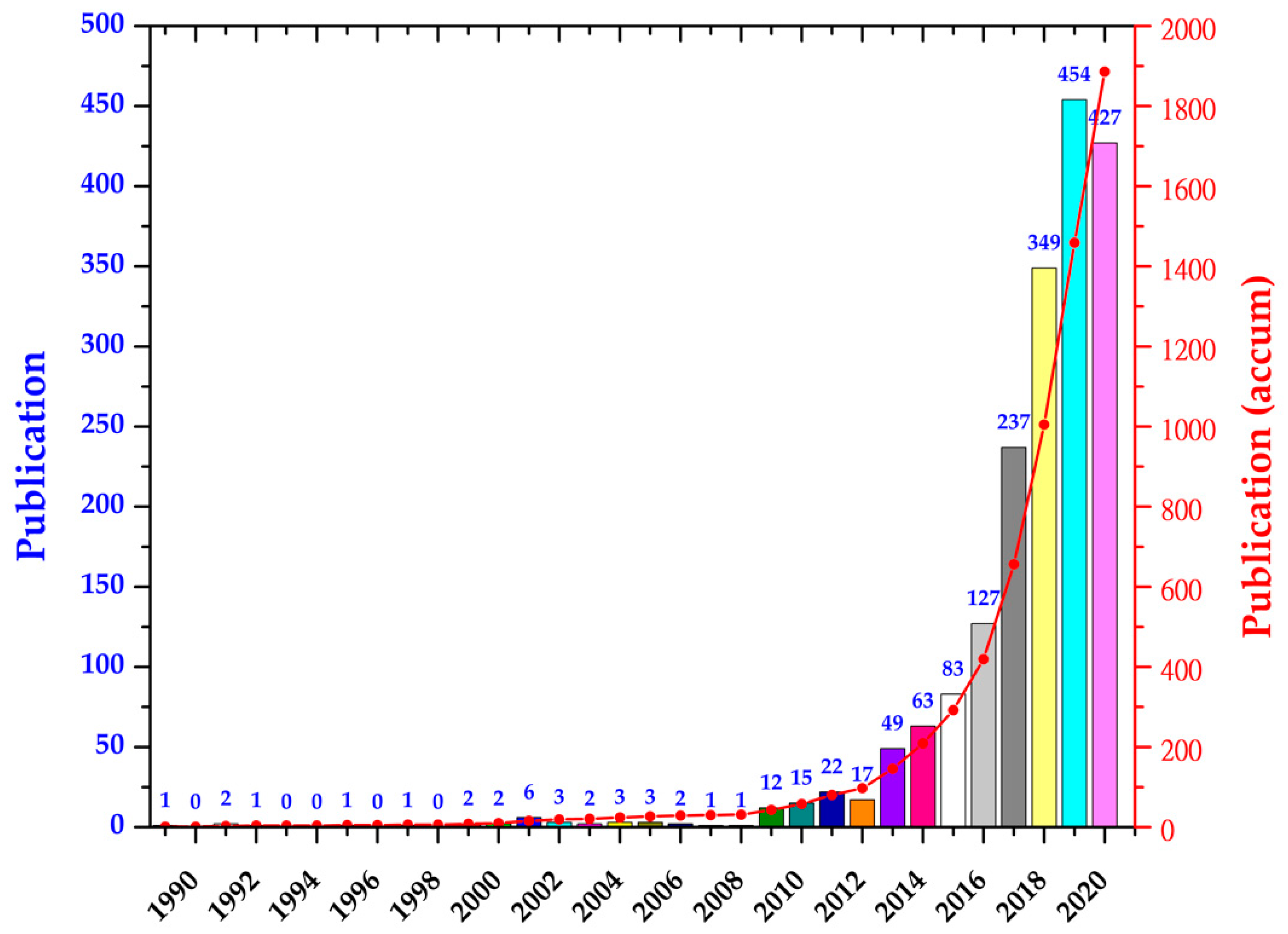
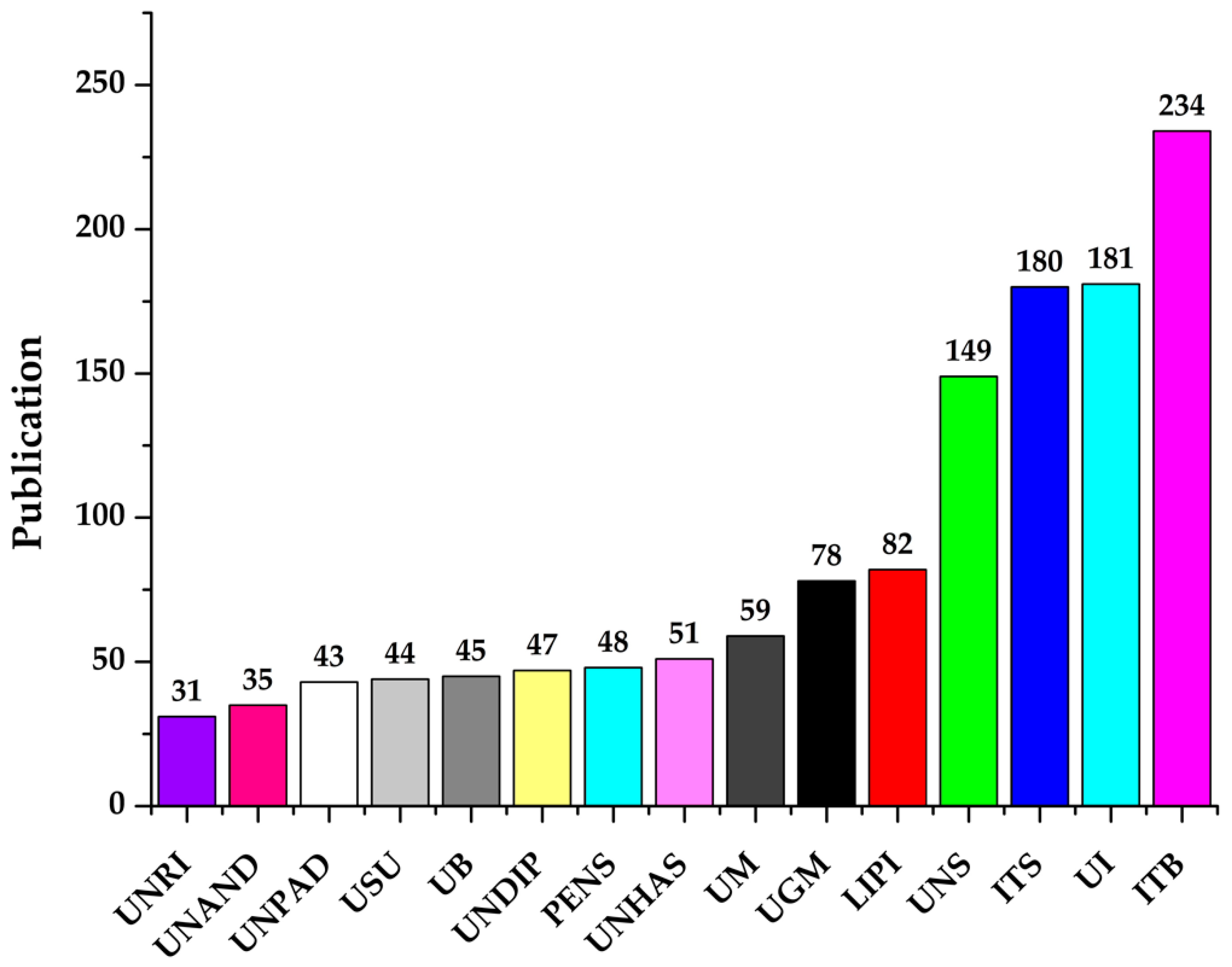
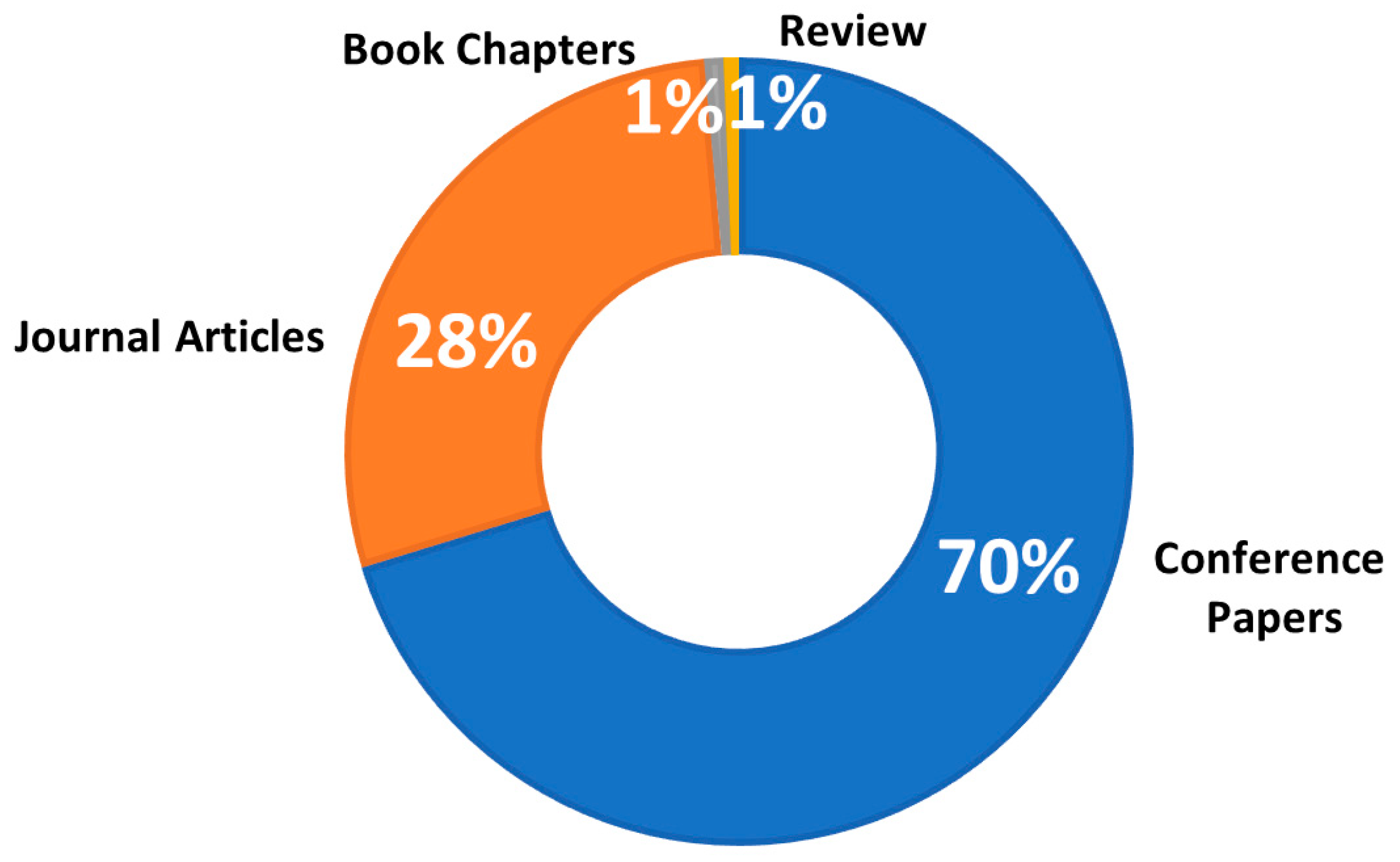
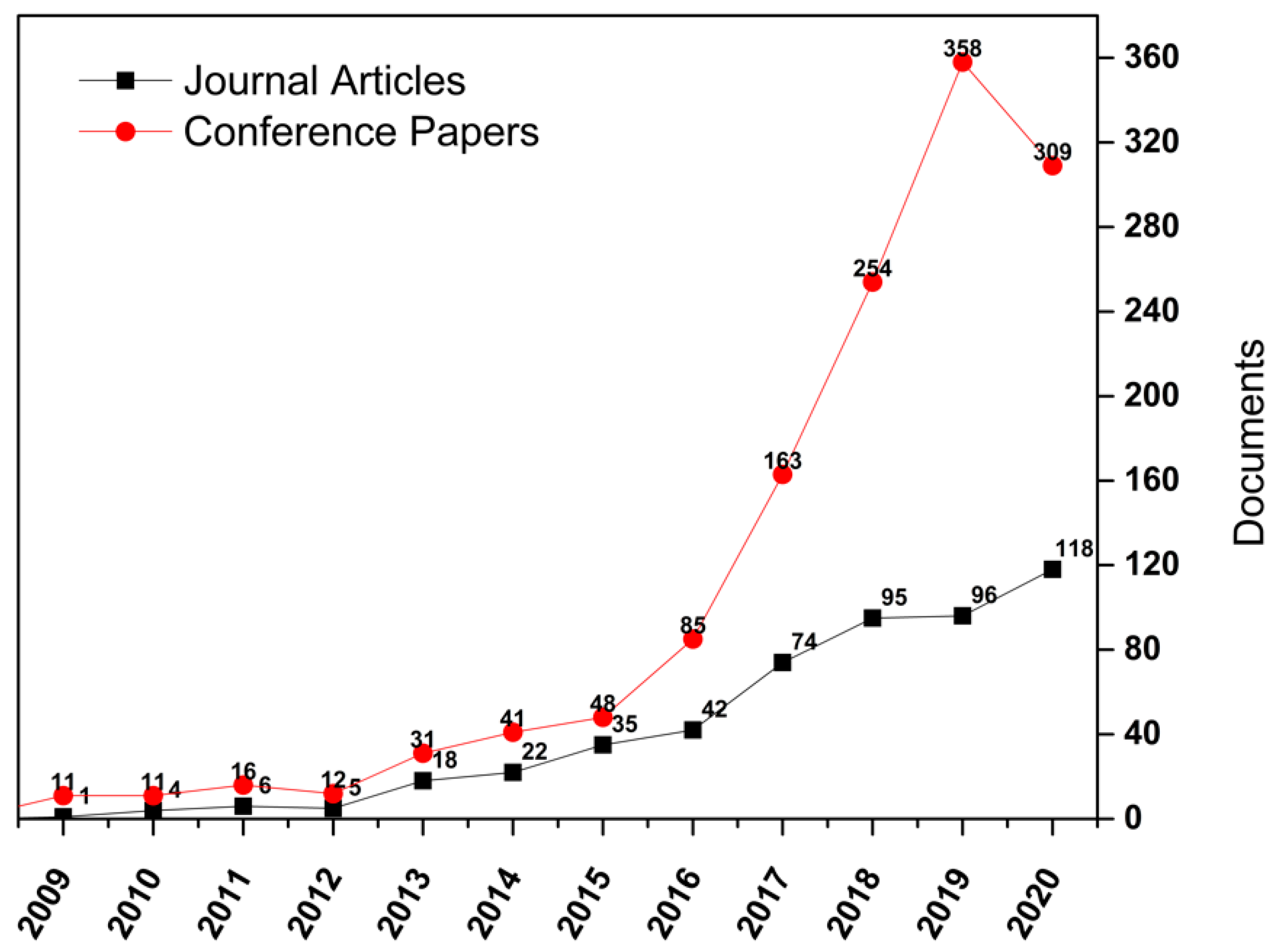



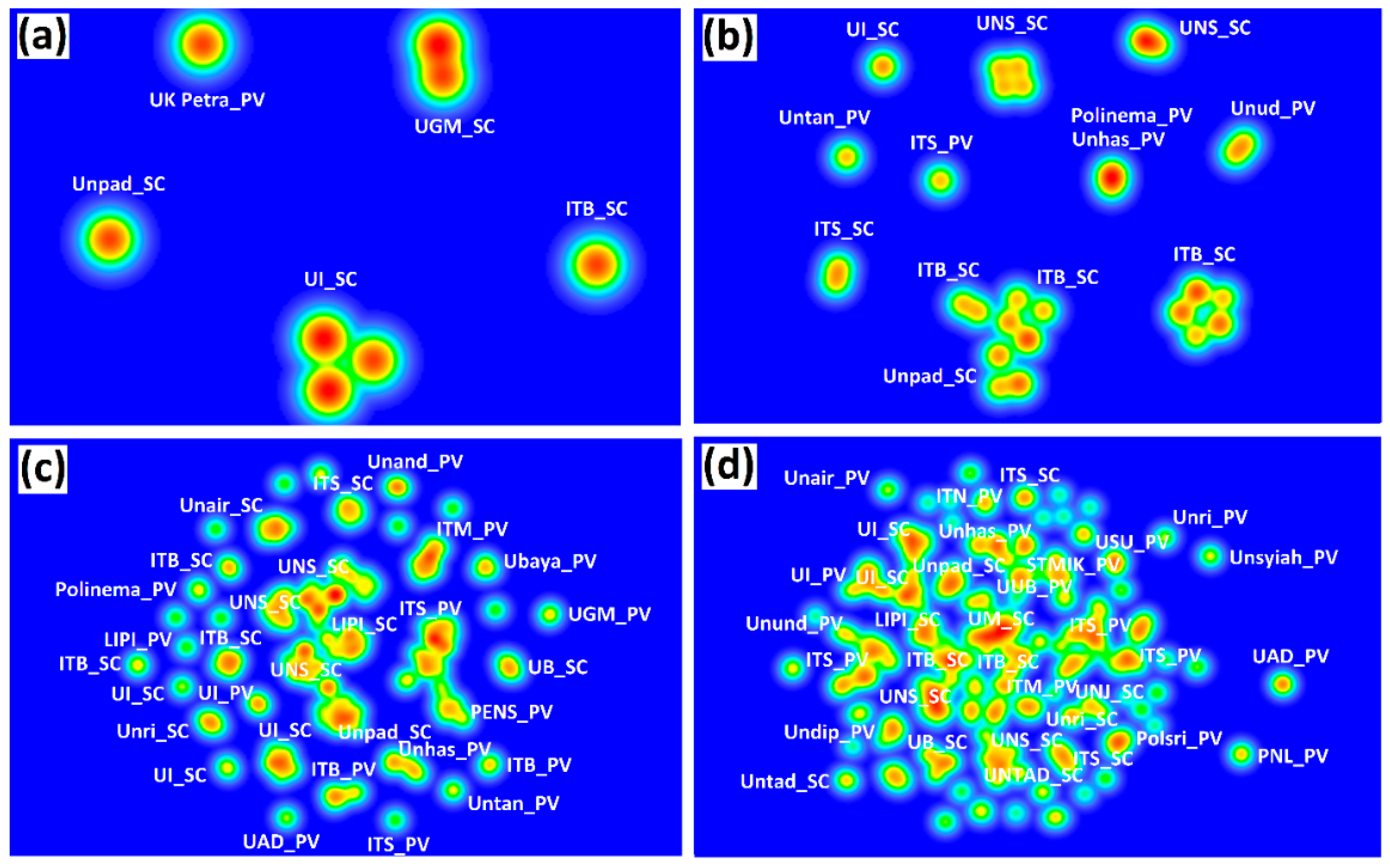


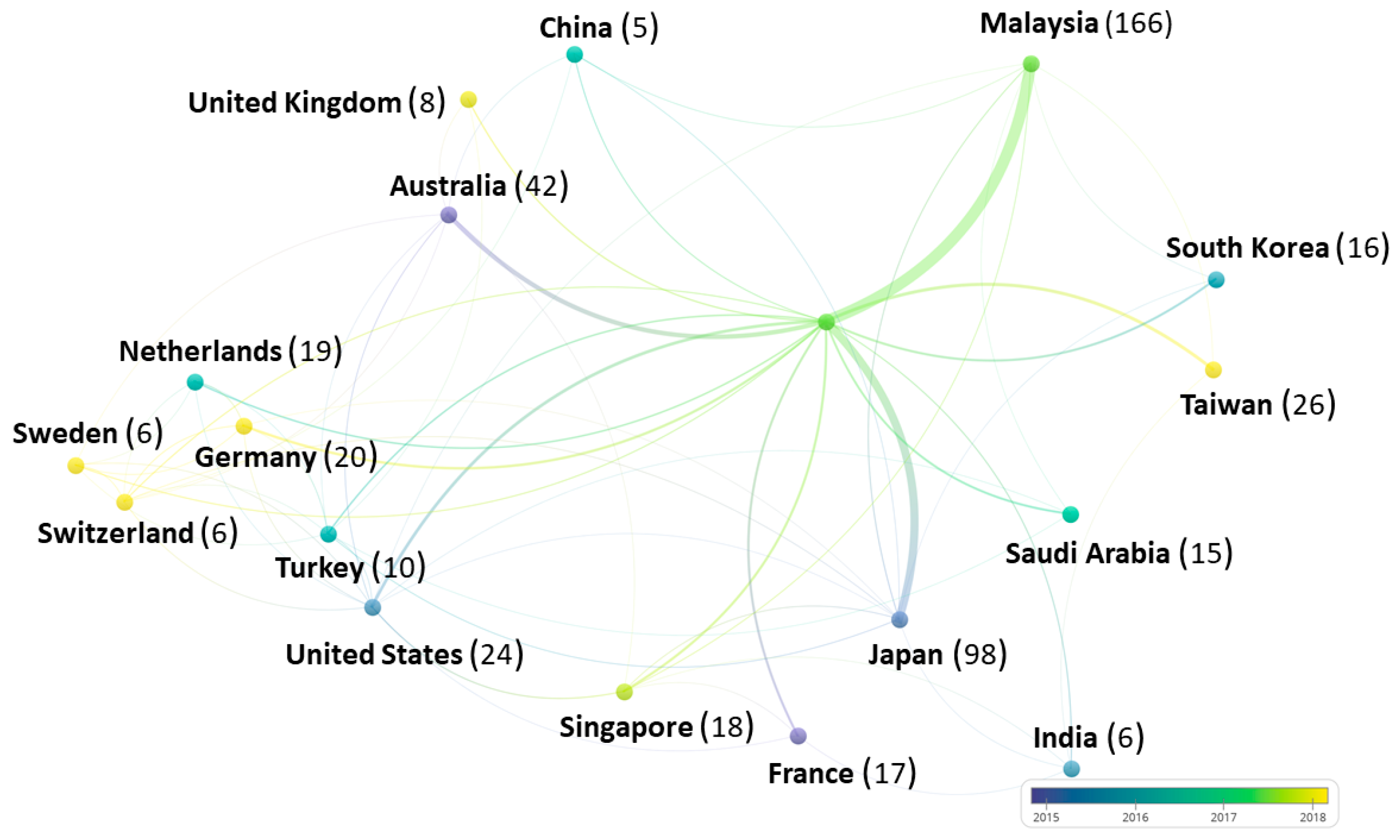
| Rationale | Included | Excluded | |
|---|---|---|---|
| Publication type | The aim of this study is to map research on solar energy research in Indonesia | All publication types, such as research articles, conference papers, reviews, book chapters, and more | |
| Quality of Publication | High-quality content ensures the validity and reliability of output research. Here, the publications were only taken from an indexed-reputable database | Scopus-indexed | Outside Scopus-indexed |
| Affiliation | The author(s) only select the publications that display Indonesian research institutions in the affiliation | Has at least one Indonesian institution in the affiliation | Publication does not display Indonesian institutions in the affiliation |
| Timeframe | The timeframe was not specified because the goal of this study is to build a comprehensive understanding of the topic rather than just the most recent. However, we restricted the timeframe to until 2020 | Before 2021 | From 2021 onward |
| Content | This study aims to investigate all publications affiliated with Indonesian institutions concerned with photovoltaic or solar cell technology | The title, abstract, and keywords include “photovoltaic” or “solar cell” | It does not have the words “photovoltaic” or “solar cell” in the title, abstract, or keywords. |
| Publication Venue | |||||
|---|---|---|---|---|---|
| Rank | Documents | Conference Proceeding | Journal Publication | Documents | Rank |
| 1 | 456 | Institute of Physics (IOP) Publishing | International Journal of Power Electronics and Drive Systems | 31 | 1 |
| 2 | 434 | Institute of Electrical and Electronics Engineers (IEEE) | Telecommunication Computing Electronics and Control (Telkomnika) | 28 | 2 |
| 3 | 164 | American Institute of Physics (AIP) | International Journal of Technology | 17 | 3 |
| 4 | 60 | E3S Web of Conferences | Renewable Energy (Elsevier) | 16 | 4 |
| 5 | 59 | Trans Tech Publications Ltd | Solar Energy Materials and Solar Cells | 10 | 5 |
| Policy | Year |
|---|---|
| Law No. 30 of 2007 on Energy | 2007 |
| Government Regulation No. 79 of 2014 on National Energy Policy | 2014 |
| Presidential Regulation No. 22 of 2017 on General Planning for National Energy | 2017 |
Publisher’s Note: MDPI stays neutral with regard to jurisdictional claims in published maps and institutional affiliations. |
© 2021 by the authors. Licensee MDPI, Basel, Switzerland. This article is an open access article distributed under the terms and conditions of the Creative Commons Attribution (CC BY) license (https://creativecommons.org/licenses/by/4.0/).
Share and Cite
Madsuha, A.F.; Setiawan, E.A.; Wibowo, N.; Habiburrahman, M.; Nurcahyo, R.; Sumaedi, S. Mapping 30 Years of Sustainability of Solar Energy Research in Developing Countries: Indonesia Case. Sustainability 2021, 13, 11415. https://doi.org/10.3390/su132011415
Madsuha AF, Setiawan EA, Wibowo N, Habiburrahman M, Nurcahyo R, Sumaedi S. Mapping 30 Years of Sustainability of Solar Energy Research in Developing Countries: Indonesia Case. Sustainability. 2021; 13(20):11415. https://doi.org/10.3390/su132011415
Chicago/Turabian StyleMadsuha, Alfian Ferdiansyah, Eko Adhi Setiawan, Nurhadi Wibowo, Muhammad Habiburrahman, Rahmat Nurcahyo, and Sik Sumaedi. 2021. "Mapping 30 Years of Sustainability of Solar Energy Research in Developing Countries: Indonesia Case" Sustainability 13, no. 20: 11415. https://doi.org/10.3390/su132011415
APA StyleMadsuha, A. F., Setiawan, E. A., Wibowo, N., Habiburrahman, M., Nurcahyo, R., & Sumaedi, S. (2021). Mapping 30 Years of Sustainability of Solar Energy Research in Developing Countries: Indonesia Case. Sustainability, 13(20), 11415. https://doi.org/10.3390/su132011415






